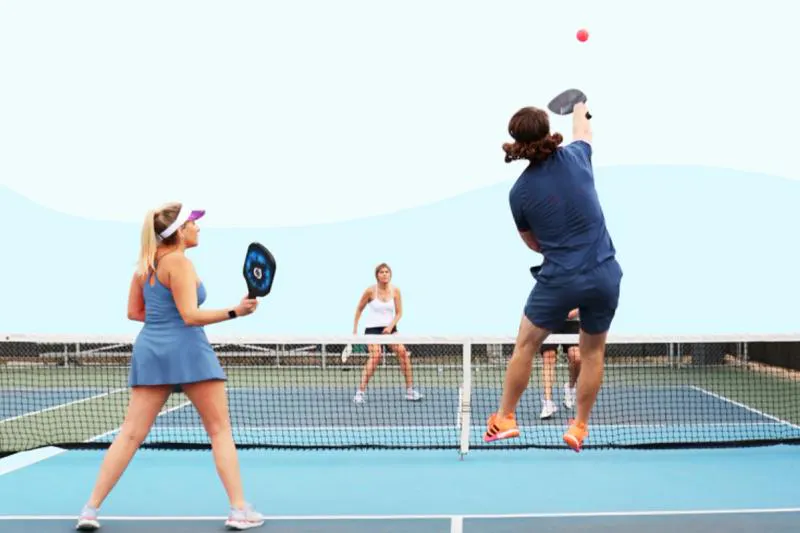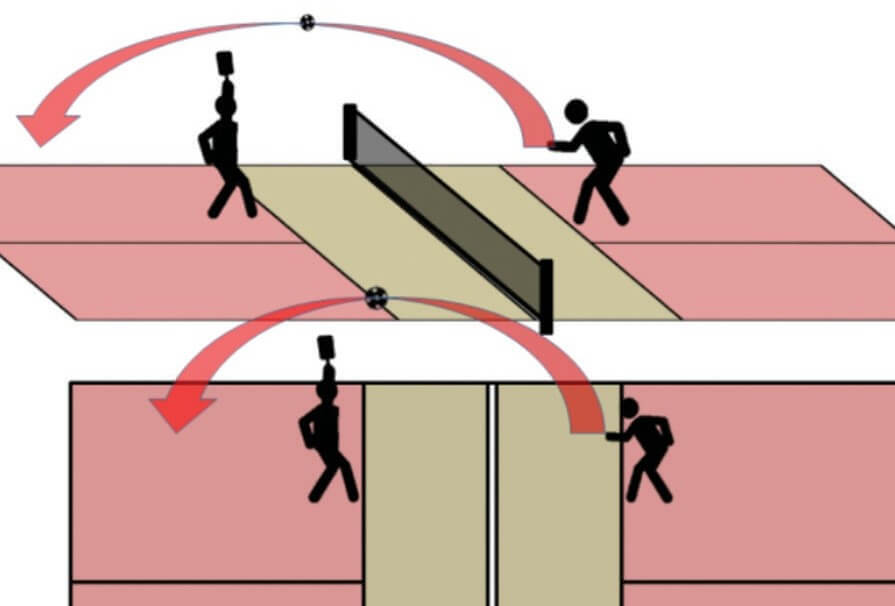The lob shot is a well-known word in pickleball, but it is also known by many other names, including sky shot, pop up, sky ball, moon ball, high floaty ball, and so on. Well, maybe not the final one, but you get the point. The lob shot is a versatile yet powerful shot that can give you an advantage on the court, but it doesn’t garner as much attention as other pickleball shots like dinks, volleys, third-shot drops, and others. Why is that? When it comes to dinks, volleys, and third-shot drops, they all have one thing in common: they all have precise instructions on how and when to utilize them.
However, the lob shot is frequently left out of the discussion, waiting for its day to shine. It’s a misunderstood shot since players don’t know how to use it in a rally or what cues to look for. I believe it is time to clarify the air and answer the most often asked questions about pickleball lob shots.
So join me as I walk you through all you need to know about the lob shot, the most known but least used shot in pickleball. Let’s start with a definition…
What’s a Lob Shot Pickleball?
A lob shot is a deep, high-flying shot produced by angling the face of a pickleball paddle. Lobbing in pickleball refers to pushing opponents away from the kitchen line (non-volley line) and back to their baseline, creating breathing room and space for oneself, or surprising an opponent with an unexpected shot (Offensive).

The last one is very useful when an opponent is becoming used to your playing style, such as expecting a softer shot, such as a drop shot. This usually causes your opponent to move closer to the kitchen line and its edges. A well-placed lob will have them sprinting for the ball before committing a double bounce fault (defensive).
Offensive lobs in Pickleball
The offensive lob is a fictitious shot that hits from your non-volley line when your opponents are leaning too far forward in expectation of a gentle dink shot.

Hitting an offensive lob will move your opponents away from the non-volley line, giving you and your partner a rally-winning advantage with you up and your opponents back on the court. It will also generate fear and uncertainty the next time your opponents are near the non-volley line, as they will be cautious of leaning forward too much.
How to Hit an Offensive Lob
An offensive lob should be shot from just behind the non-volley line. The lob should normally be hit over your opponent’s non-paddle shoulder (backhand) for the best location. In addition, the offensive lob should only be used in response to a non-intentional (dead) dink from your opponent.
The method for passing a successful lob in pickleball is similar to the dink shot in that it emphasizes delicacy and precision. Consider the following crucial components while mastering the lob:
- Grip: Adopt a soft, relaxed continental grip, similar to a hammer grip. This grip gives you the control you need to accurately finesse the ball over the net.
- Backswing: Reduce or eliminate your backswing to keep control and avoid telegraphing your shot. Keeping your swing compact enables faster execution, catching your opponents off guard.
- Body Position: Maintain a steady and balanced posture by staying low with your knees slightly bent. This position gives you more control over your shot and allows you to move quickly and fluidly.
- Contact Point: Similar to a dink shot, make contact with the ball in front of your body. This posture improves control and ensures that the ball clears the net with the appropriate trajectory.
- Lift and Control: Direct the ball out and up using a pushing motion. The purpose is to have the ball just clear your opponent’s outstretched arm and drop deep in the court. This controlled lift is key for an effective lob.
It’s critical to make your lob shot different from a dink to add an element of deception. Avoid acts like standing erect or taking a significant step backward that might reveal your true intentions. The idea is to keep your posture and movements constant so that your opponent can’t foresee your shot.
When is the Offensive Lob a Smart Shot?
My own experience has shown me that an offensive lob may be an effective shot/strategy, especially in these certain situations:

- Non-Volley Line Pressure: When opponents loiter near the non-volley line, expecting high or deep dinks to catch them off guard and seize control of the point.
- Limited Opponent Mobility: When one or both of your opponents aren’t extremely fast or nimble – But don’t overuse the lob in recreational play. It’s unlikely to make you popular.
- Against the Wind: To improve control and make it harder for opponents to counterattack, choose lobs while hitting against the wind.
- Sunlight Visibility Issues: Take advantage of the sun’s obscuring sight for opponents by executing well-executed lobs to complicate their ball tracking.
- Weakness in Overheads: When your opponent is dealing with overheads, use lobs to force them to deal with high, deep shots.
Strategically employing offensive lobs in these scenarios introduces unpredictability and can exploit opponents’ weaknesses on the pickleball court.
When should offensive lobs be avoided?
Pickleball has also taught me that offensive lobs are not always the greatest option. There are various situations in which you should avoid or utilize them with caution. These are the:
- When your opponent is deep in the court and can aggressively return the lob.
- When striking with the wind, since it might cause the lob to travel out of bounds or lose precision.
- When your opponent is skilled at overheads and has the ability to smash the lob back at you. When you are unsure of your technique or timing because a badly performed lob can be readily penalized by your opponent.
The Defensive Lob Shot
Unlike the offensive lob, the defensive lob is used to purchase time during the rally. Consider using a defensive lob when:

- Scrambling Across the Court: Moving quickly from side to side, use a defensive lob to give yourself time to set up for the next shot.
- Recovering from a Short Shot: your opponent’s short shot sends you rushing forward, giving you a chance to reclaim possession.
- Responding to Opponents’ Lobs: When opponents lob the ball to you and completing a drop shot is impractical, go for a defense lob.
Under these circumstances, the defensive lob turns into a calculated move to prolong the rally and change positions for next shots.
Tips to hit better lob shots in Pickleball
- Wait for the right moment. A lob works best when your opponent is near the NVZ line, expecting a dink exchange, or ready to smash a high ball.
- Add some topspin to the ball. Top spin makes it more difficult to return your lob.
- Lob against the wind, not with it. Since a pickleball court is small, it is simpler to knock the ball out when you lob it with the wind behind you.
- Hide the lob. Lobs could be lethal when your opponent is caught off guard, but they can also backfire when they are well-prepared.
- Target the non-paddle side. Your opponent will generally struggle more to return a lob shot to their non-paddle side of the court.

Conclusion
Lobs are a versatile pickleball tool that can be used for offense or defense according to the scenario, however, they are typically more effective as an offensive weapon than a defensive one. They are also more appropriate for people with beginner to intermediate skill levels.
As long as you have skills, strength, and precision — lobs may be exceptional for providing unexpected opportunities. To be a good pickleball player, you must master all shots, especially the lob. So give it a shot, but remember to vary your shots as part of your plan. With these suggestions in mind, you’ll be on your way to lobbing success.
FAQs
In pickleball, being able to execute lob shots is crucial. You should learn lobbing in pickleball as well as defend against them.
Yes, depending on the situation at hand, you can use a lob shot as an offensive or defensive weapon. A lob, on the other hand, may be dangerous and difficult to complete, therefore it should be utilized with caution and expertise.
In pickleball, three strategies to defend against lobs are to learn to predict when one will be hit, crush them with an overhead shot, or dash toward the baseline to get in position to return them.

